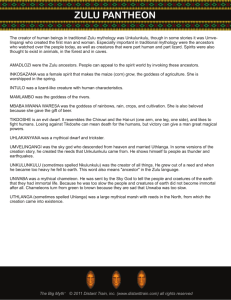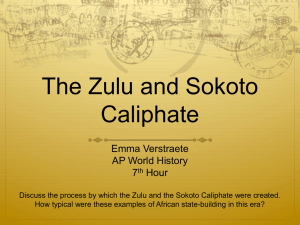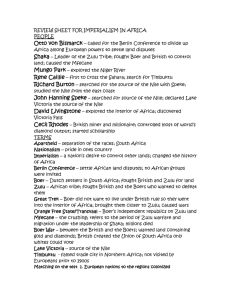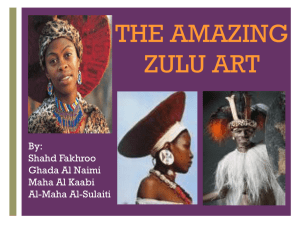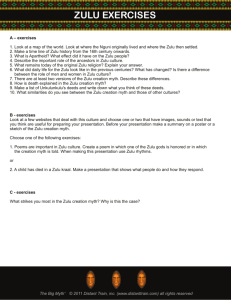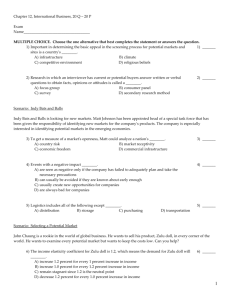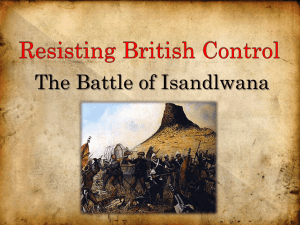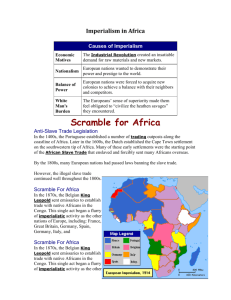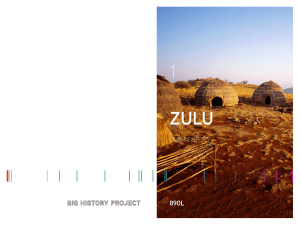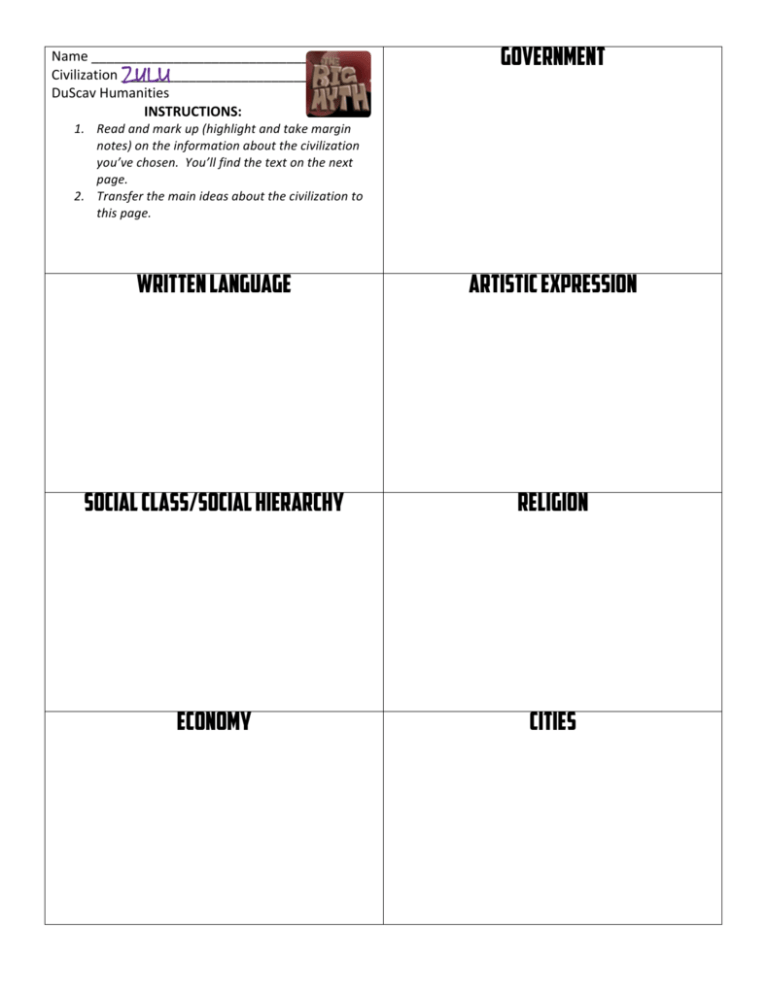
Name%_____________________________________%
Civilization%_________________________________%
DuScav%Humanities%
B%/%D%Blocks%%%%%%INSTRUCTIONS:**
Government
1. Read'and'mark'up'(highlight'and'take'margin'
notes)'on'the'information'about'the'civilization'
you’ve'chosen.''You’ll'find'the'text'on'the'next'
page.'''
2. Transfer'the'main'ideas'about'the'civilization'to'
this'page.'''
'
'
'
Written Language
Artistic Expression!
!
Social Class/Social Hierarchy
Religion!
!
Economy
!
Cities!
GEOGRAPHY)
Find)a)MAP)of)the)location)of)the)civilization.))Paste)it)here)and)include)the)URL)for)the)image.))
)
)
)
)
)
)
)
)
)
)
)
)
)
)
)
)
)
)
)
)
)
What)geographic)features)did)this)civilization)have)access)to?))How)did)these)features)help)or)
hurt)this)civilization?))
)
)
)
)
)
)
)
)
)
)
)
)
)
)
)
)
)
)
)
)
)
)
)
)
)
)
ZULU CULTURE
LOCATION
Today there are about 3 million Zulus, who mostly live in the Natal Province of South Africa. This area is sometimes called Zululand, and has a very warm climate.
HISTORY
The Zulu started as a clan that belonged to a larger group of people called the Nguni. The Nguni migrated south
from central East Africa in the 16th century to the Natal region. As they settled the Zulu built beehive shaped
grass huts to live in.
The Zulu people believe that they are the direct descendents of a chief called Zulu (which means heaven in the
Nguni language). After the death of Zulu, his descendants called themselves abakwaZulu (people of Zulu). The
Zulu people also call themselves Abantsundu, which means "brown people".
By the early 19th century the Zulu had become the strongest military force in southern Africa (under the leadership of the powerful but violent Shaka). They raided and killed many neighbors and took their land, goods and
women. Soon after this, however (around 1830), they had to face the growing colonial presence of the British,
who wanted to control the entire southern part of Africa.
It was not the first time that Europeans had seized control of land in Southern Africa. The first white Europeans
arrived in 1488. Many whites (English, Dutch, German and French) went to the nearby Cape of Good Hope to
settle starting around 1600. There, the Europeans imported slaves to work for them and a society was created of
free whites and blacks with very few rights. Many white settlers did not like British rule, however. They called
themselves Afrikaner or Boer (the Dutch word for farmer) and used their own language, called Afrikaans (which
resembles Dutch). The Afrikaners and English fought for power for many years.
After much tension between the Zulu people and the Europeans a war broke out in 1879. Though the Zulus had
some success in driving back the British in the very beginning, the superior weapons and horses of their enemies
led to the rapid defeat of the Zulu. The last military attempt to keep their land free of the British took place in 1906.
After the British defeated the Zulu and the other native peoples of South Africa a period of British white colonial
domination began. The Union of South Africa was created in 1910, and South Africa thus became officially independent. Afrikaans became the dominant language. Whites had all the power and wealth in this new nation and
the black population became second class citizens with almost no political power. In 1948 a racist government
came into power that started the practice of Apartheid. New Apartheid laws soon made Zulus and other blacks (as
well as other ethnic groups) officially inferior to whites, and kept the different groups completely separate. During
the Apartheid period the Zulus tried to resist the domination of the whites in every aspect of life, but they had little
power to live the lives they wanted.
Since the transition to democracy in 1994 (when Nelson Mandela became president), and the end of Apartheid,
the Zulus have struggled against the new South African government for the right to run their own affairs. This has
led to a lot of violence in the last ten years.
RELIGION
The Zulu religion is based on the creator god Unkulunkulu and the worship of ancestors. The creator god is
almighty, but has little to do with everyday affairs. The spirit world, on the other hand, is always present in traditional Zulu religion. It is believed that when a person dies this person's spirit will watch over the others from this
spirit world. People can come into contact with the spirit world and one's ancestors during special ceremonies.
The spirits of the ancestors like to be remembered. People make offerings (like beer and meat) to the spirits to
show them that they have not been forgotten. Because it is so important to honor the spirits there are many rituals
in Zulu daily life that are meant to please the spirits. According to the more traditional Zulu belief all misfortune is
due to evil magic or to spirits that have been offended. Another important part of Zulu religion is cleanliness.
People will bathe up to three times a day.
The Big Myth
TM
© 2011 Distant Train, inc. (www.distanttrain.com) all rights reserved
At the end of the1700s, missionaries attempted to convert the Zulus to Christianity (mostly Protestant); due to the
Zulus strong beliefs and community, this has only been partially successful. Many Zulus today practice a type of
religion that is a mixture of Christianity and their own traditional religion.
SOCIETY, ECONOMY AND POLITICS
In the past centuries the Zulus preferred to live in homesteads (a group of huts called kraals) instead of villages.
The huts in the homestead formed a circle. There was a cattle pen in the middle of the circle where the Zulus kept
their livestock. Traditional huts were built by using small trees with grass mats on top. The floor was made of clay
and cow dung that was rubbed hard into a smooth and shiny surface.
Traditional Zulu society has chiefs and a king. Several homesteads were traditionally run by one chief, who made
the important decisions. There was one Zulu king who represented all the Zulu. He played an important role in the
politics of the Zulu territory throughout history and has represented his people internationally. Today, Zulu kinds
are still respected but this traditional power structure clashes with the central and democratic government of
South Africa.
The Zulu who live primarily in the rural part of South Africa tend to raise cattle and also grow corn and vegetables
(such as corn, beans, yams and millet). The men and boys have been traditionally responsible for the herds of
cattle, goats and sheep, while the women have been responsible for the planting and harvesting of crops.
Men play the dominant role in Zulu families. The men own the huts, make the decisions, receive visitors and go to
war. They are also allowed to have more than one wife. When they are young, girls learn to cook, plant crops and
take care of the children. After marriage, Zulu brides traditionally move in with their husbands and their husbands'
families. The husband and his family give the bride's family some cattle as a gift in return. In the past, the only
way to inherit property was through the father. Mothers are primarily responsible for their children, but children
tend to grow up with a large number of other people who are all seen as family.
The Zulu who live in urban areas are still suffering from the history of Apartheid. They have a hard time competing
for jobs and most do unskilled labor (men) and domestic work (women).
CULTURE
The Zulu have close ties to other Nguni people such as the Swazi and Xhosa, and their cultures are quite similar.
Zulus speak the Kwazulu language, which is a mixture of several other languages.
Traditionally men and women are involved in different types of arts and crafts. The Zulu women are best known
for their beadwork and basket making, while men are known for their wood carvings and for the objects they
make out of animal skins.
Poetry has long been an important art form among men. The poems of the past praised kings and national
heroes. Poems today are often more political and talk about the history of Apartheid and Zulu life today. Storytelling and riddles have also always been popular form of entertainment.
The Big Myth
TM
© 2011 Distant Train, inc. (www.distanttrain.com) all rights reserved
INSTRUCTIONS:**
The _________ Pantheon
'
Read'and'mark'up'(highlight'and'take'margin'notes)'on'the'Pantheon'of'your'civilization'(the'information'is'on'the'
next'page'of'this'document).''Then'come'back'to'this'sheet'and'answer'these'questions.'''
%
As%you%read%about%the%Pantheon%(literally%“all%the%gods”)%of%your%civilization,%what%do%you%notice?%%%
• Chief%god:%
%
%
• Gods%with%interesting%powers:%
%
%
%
%
%
• Which%gods%are%the%most%powerful/important:%
%
%
%
%
%
• What’s%%the%breakdown%between%male%and%female%gods?%%
%
%
%
%
%
• What%do%these%gods%seem%to%show%about%the%culture’s%view%on%the%nature%of%humanity?%%How%to%the%gods%
behave?%%What%sorts%of%qualities%do%they%have?%%
%
%
%
%
%
%
• Anything%else%that%strikes%you?%%
ZULU PANTHEON
The creator of human beings in traditional Zulu mythology was Unkulunkulu, though in some stories it was Umvelinqangi who created the first man and woman. Especially important in traditional mythology were the ancestors
who watched over the people today, as well as creatures that were part human and part lizard. Spirits were also
thought to exist in animals, in the forest and in caves.
AMADLOZI were the Zulu ancestors. People can appeal to the spirit world by invoking these ancestors.
INKOSAZANA was a female spirit that makes the maize (corn) grow, the goddess of agriculture. She is
worshipped in the spring.
INTULO was a lizard-like creature with human characteristics.
MAMLAMBO was the goddess of the rivers.
MBABA MWANA WARESA was the goddess of rainbows, rain, crops, and cultivation. She is also beloved
because she gave the gift of beer.
TIKDOSHE is an evil dwarf. It resembles the Chiruwi and the Hai-uri (one arm, one leg, one side), and likes to
fight humans. Losing against Tikdoshe can mean death for the humans, but victory can give a man great magical
powers.
UHLAKANYANA was a mythical dwarf and trickster.
UMVELINQANGI was the sky god who descended from heaven and married Uthlanga. In some versions of the
creation story, he created the reeds that Unkulunkulu came from. He shows himself to people as thunder and
earthquakes.
UNKULUNKULU (sometimes spelled Nkulunkulu) was the creator of all things. He grew out of a reed and when
he became too heavy he fell to earth. This word also means "ancestor" in the Zulu language.
UNWABA was a mythical chameleon. He was sent by the Sky God to tell the people and craetures of the earth
that they had immortal life. Because he was too slow the people and creatures of earth did not become immortal
after all. Chameleons turn from green to brown because they are sad that Unwaba was too slow.
UTHLANGA (sometimes spelled Uhlanga) was a large mythical marsh with reeds in the North, from which the
creation came into existence.
The Big Myth
TM
© 2011 Distant Train, inc. (www.distanttrain.com) all rights reserved
ZULU CREATION
Long ago, before man or any animals roamed the earth, there was just darkness and
one very large seed.
The seed sank into the earth and from it, long reeds began to grow.
They were called “Uthlanga”, which means the source of all things.
Slowly, one reed grew into a man.
It was Unkulunkulu, First Man, and the creator of all things.
The larger he grew the heavier he became. Finally, when he was fully-grown, he broke
off from the reed and fell to earth.
As he strolled up and down the earth, he saw other growing reeds forming into men and
women.
Unkulunkulu broke off the first men and women; medicine men and their dreams. He
pulled off cattle and fish and birds and fierce creatures.
He created streams and mountains, lakes and valleys, wind and rain and the sun and
the moon.
Unkulunkulu created everything we see around us today.
He taught the first men and women how to hunt and make fire, how to make clothes and
prepare corn. He gave all of the animals their names.
When all of this was done, Unkulunkulu sent the languid chameleon out into the world
with the message that his people will never die.
The chameleon plodded on his mission slowly, slowly, slowly.
After several days, Unkulunkulu became impatient and sent a speedy lizard out into the
world with the message that Death was on its way.
The swift lizard quickly overtook the chameleon and arrived at the village first.
Once the lizard brought its message to the first people, Death arrived shortly thereafter.
It has never left mankind since.

